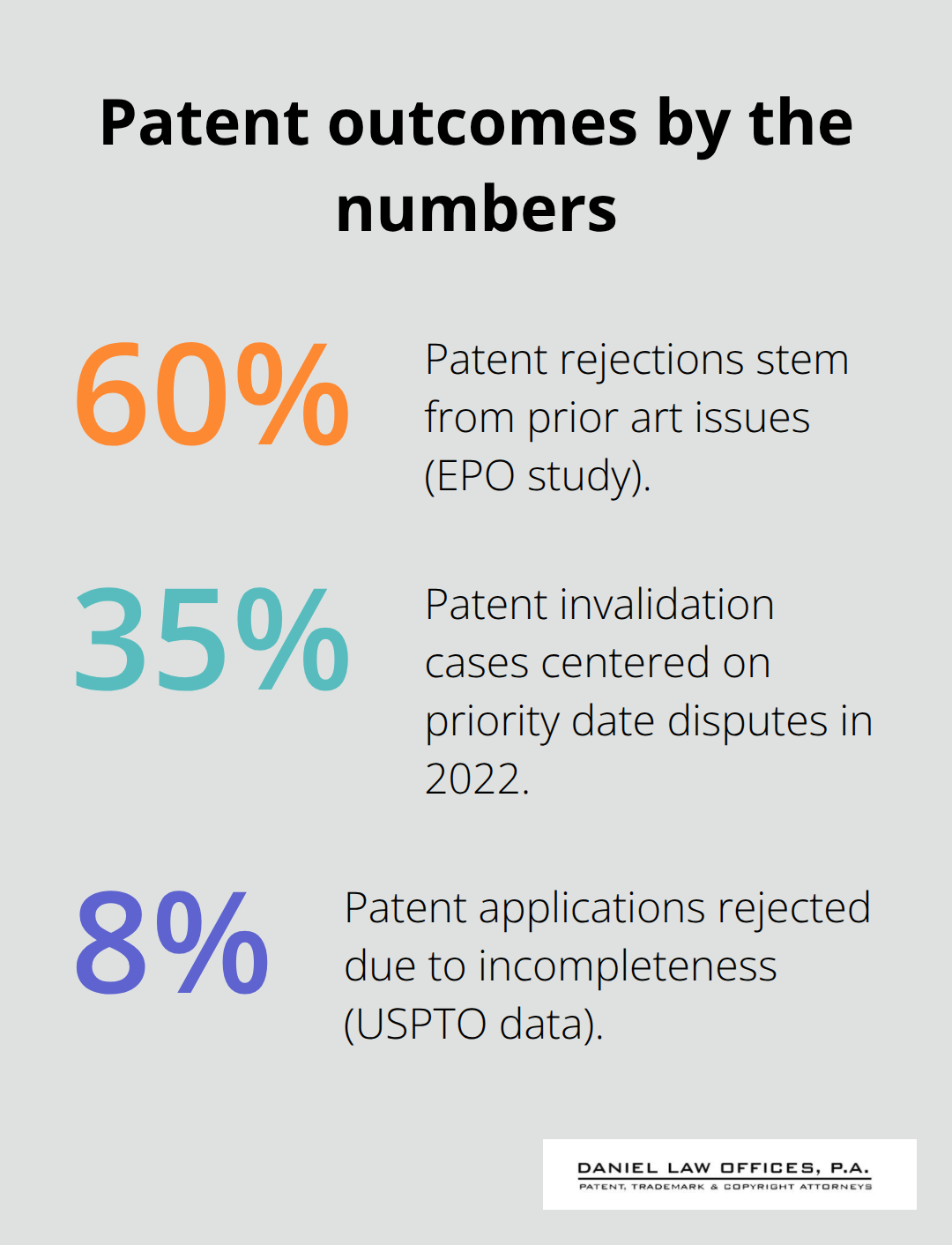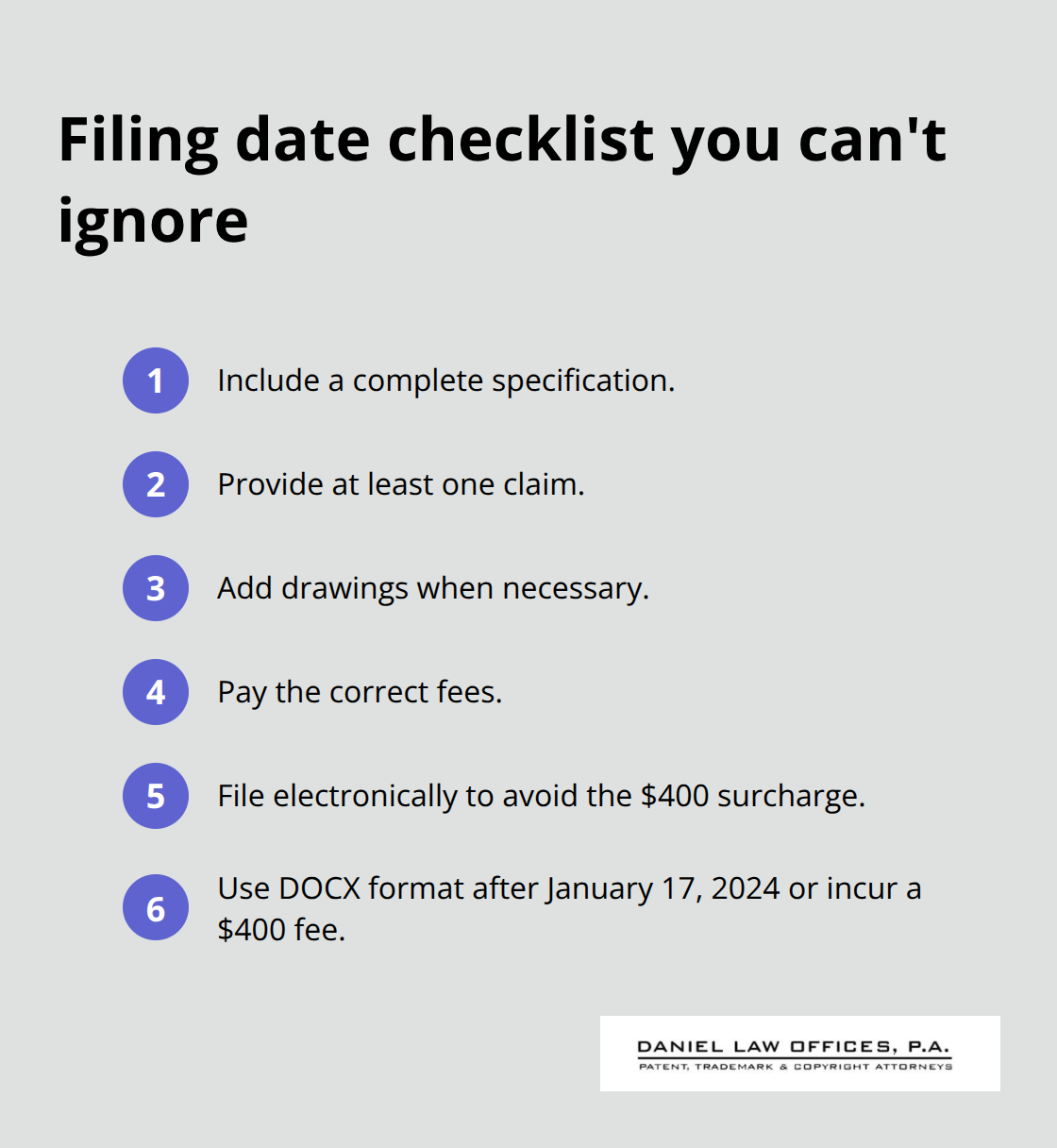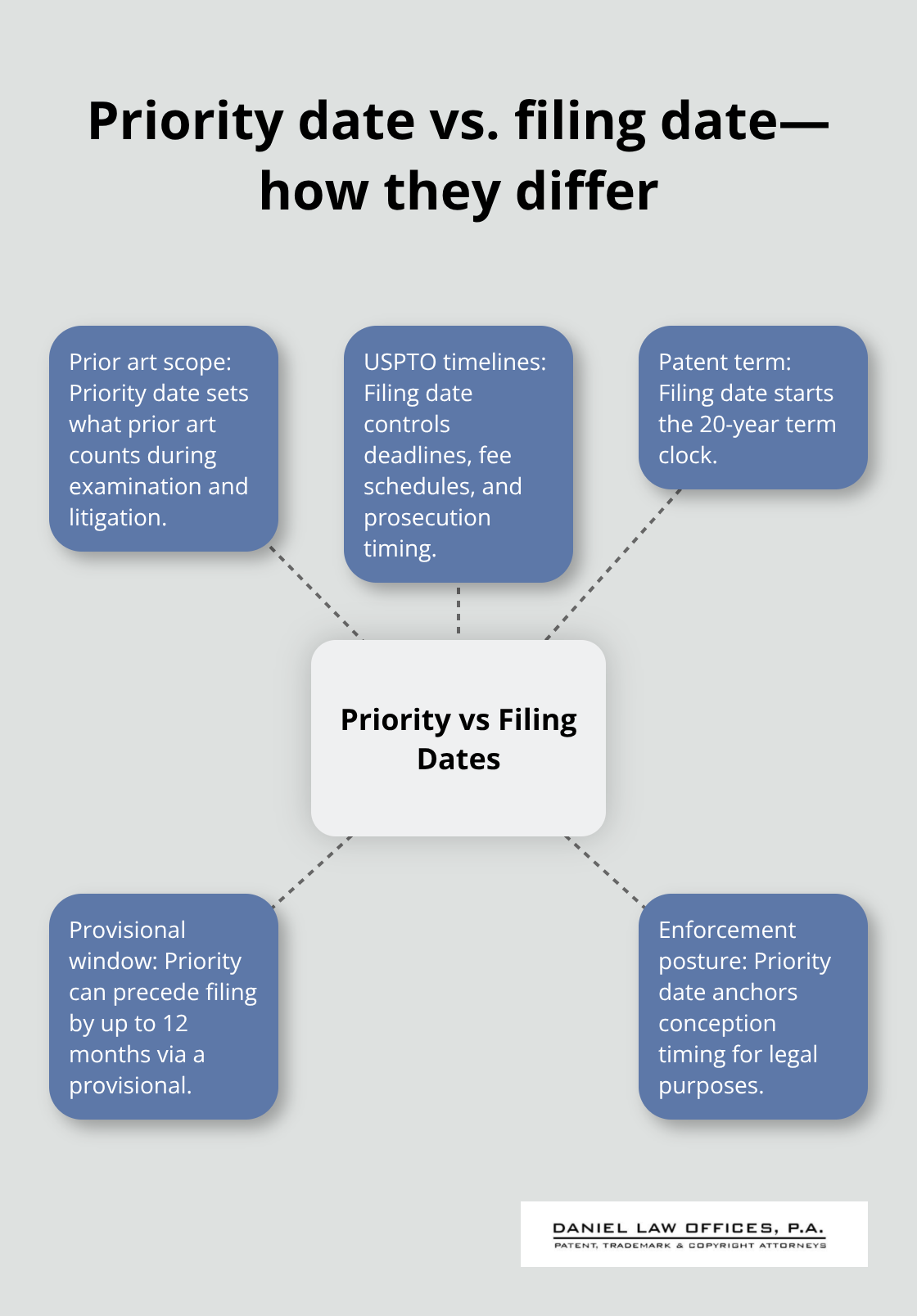Patent Priority Date vs Filing Date in Orlando, Florida [Key Differences]
Patent applications involve multiple critical dates that determine your intellectual property rights. Understanding patent priority date vs filing date can make or break your patent strategy.
We at Daniel Law Offices, P.A. see inventors in Orlando frequently confuse these two dates, leading to costly mistakes. Each date serves a distinct legal purpose and affects your patent rights differently.
What Makes Patent Priority Date So Important?
Priority Date Establishes Your Patent Rights
Patent priority date marks when your invention was first disclosed to the patent office and forms the foundation for all patent rights. This date determines which prior art the United States Patent and Trademark Office can use against your application during examination.
The USPTO received over 600,000 patent applications in 2022, which makes priority dates essential for inventors who compete in crowded fields. Your priority date can originate from a provisional application, non-provisional application, or foreign filing under treaty agreements.
When you file a provisional application, you secure a priority date for 12 months while you develop your invention further. Approximately 170,000 provisional applications were filed in the U.S. in 2022, which reflects their strategic importance for inventors who seek early protection.
Priority Date Affects Patent Validity
Patent validity depends heavily on your priority date since it determines what counts as prior art against your invention. A European Patent Office study found that 60% of patent rejections stem from prior art issues, which makes early priority dates valuable for patent success.
Your priority date also influences patent enforcement because it establishes when your invention was conceived for legal purposes. In 2022, 35% of patent invalidation cases centered on priority date disputes (highlighting their importance in litigation).

Priority Date Benefits Under First-to-File System
The first-to-file system rewards inventors who establish priority dates quickly, regardless of who invented first. Patent applications face an 8% rejection rate due to incompleteness, which emphasizes the need for proper priority date establishment.
Patent attorneys help inventors secure valid priority dates and avoid costly mistakes that weaken patent positions. The average time between invention disclosure and patent filing decreased by 15% from 2018 to 2022, which shows the increased urgency inventors face in today’s competitive landscape.
Understanding how filing dates differ from priority dates becomes essential for developing effective patent strategies.
What Determines Your Patent Filing Date?
Patent filing date represents the official date when the United States Patent and Trademark Office receives your complete patent application. This date initiates your patent term (which typically lasts 20 years for utility patents) and starts the clock on all USPTO deadlines.
The filing date differs from priority date because it marks when you submitted your actual application rather than when you first disclosed your invention. Your filing date becomes part of the public record and affects patent prosecution timelines, fee calculations, and legal obligations throughout the patent process.
Filing Date Requirements You Cannot Ignore
The USPTO demands strict compliance with filing requirements, and missing any component delays your filing date or results in application abandonment. Your application must include a complete specification, at least one claim, appropriate drawings when necessary, and correct fees to establish a valid filing date.

The basic filing fee for a utility patent application reached $320 for large entities in 2023, though small entities receive up to 60% reductions and micro entities get up to 80% fee reductions. Electronic filing through Patent Center avoids the $400 non-electronic filing surcharge, and applications must use DOCX format as of January 17, 2024, or face an additional $400 fee.
Patent applications face an 8% rejection rate due to incompleteness according to USPTO data, which means thorough preparation prevents costly delays.
Filing Date Impact on Patent Protection
Your filing date determines which prior art the USPTO considers during examination and establishes your position in the first-to-file system. A World Intellectual Property Organization study found that 12% of patent applications face initial rejection due to formatting issues, which can push back your effective filing date if substantial changes are needed.
Filing dates also control continuation application deadlines, response periods for office actions, and maintenance fee schedules throughout your patent’s lifetime. Patent applications that claim priority from earlier filings can maintain earlier effective dates while still having later actual filing dates, which provides strategic advantages in patent prosecution.
These distinctions between filing dates and priority dates create important differences that directly impact your patent strategy and legal rights.
How Do Priority Date and Filing Date Work Differently?
Priority date and filing date operate on separate timelines that create distinct legal consequences for patent applicants. Priority date can precede filing date by up to 12 months when you claim priority from a provisional application, which means your invention receives protection against prior art from the earlier date while your actual application enters the USPTO system later.
Timeline Differences Create Strategic Advantages
This timeline difference becomes powerful when competitors file similar patents between your priority date and filing date, because your earlier priority date blocks their patent rights. Filing date controls all USPTO deadlines, fee schedules, and prosecution timelines, while priority date determines what prior art can invalidate your patent during examination and litigation.
Your filing date starts the 20-year patent term clock and triggers all USPTO response deadlines, but your priority date determines patent validity against competing inventions. These separate functions mean inventors must track both dates carefully to maintain patent rights and meet legal obligations.

Patent Prosecution Creates Common Mistakes
Patent applicants lose valuable rights when they misunderstand how these dates affect prosecution deadlines and continuation applications. Continuation applications must claim priority from parent applications filed within specific timeframes, and missing these deadlines eliminates your ability to add new claims or features while maintaining early priority dates.
Patent attorneys see inventors lose patent rights when they assume priority date and filing date create identical legal obligations (which leads to missed deadlines and weakened patent portfolios). The USPTO requires strict compliance with both timeline systems, and confusion between these dates costs inventors money and protection.
Strategic Date Management Protects Patent Rights
Smart inventors file provisional applications early to secure priority dates, then use the 12-month window to refine inventions before filing costly non-provisional applications. This strategy protects against the 60% of patent rejections that stem from prior art issues according to European Patent Office data, while giving inventors time to assess commercial viability before major patent expenses.
However, provisional applications that expire without non-provisional filings lose all priority benefits (which transforms early protection into wasted fees and missed opportunities for patent rights). Inventors must convert provisional applications within 12 months or forfeit their early priority dates permanently.
Final Thoughts
Patent priority date vs filing date creates two separate legal timelines that directly impact your intellectual property rights in Orlando, Florida. Priority date determines what prior art can invalidate your patent and establishes your position against competitors. Filing date controls USPTO deadlines, fee schedules, and patent term calculations.
These distinctions become critical when you file provisional applications to secure early priority dates or claim priority from foreign applications. Orlando inventors who understand these differences gain strategic advantages in patent prosecution and enforcement. The 60% rejection rate from prior art issues and 35% of invalidation cases that involve priority disputes show why proper date management matters for patent success.
We at Daniel Law Offices, P.A. help inventors navigate these complex requirements and develop effective patent strategies (through proper priority date and filing date management). Our registered patent attorney guides clients through patent searches, application preparation, and USPTO prosecution to protect valuable innovations. Contact Daniel Law Offices, P.A. to secure your patent rights with professional legal guidance.

![Patent Priority Date vs Filing Date in Orlando, Florida [Key Differences]](https://danielpatents.com/wp-content/uploads/emplibot/Patent-Priority-Date-vs-Filing-Date-in-Orlando_-Florida-_Key-Differences__1760753201.jpeg)